Fri 26 Jun 2009
Western movie review: ANY GUN CAN PLAY (1967).
Posted by Steve under Reviews , Western movies[4] Comments
ANY GUN CAN PLAY. 1967, a/k/a Vado… l’ammazzo e torno. Made in Italy; dubbed into English. Edd Byrnes, George Hilton, Gilbert Roland, Kareen O’Hara (Stefania Careddu), Gerard Herter. Director: Enzo G. Castellari.
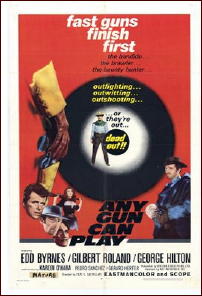
The opening scene is quite spectacular, and while the rest of the movie doesn’t quite match up, parts of it do, and it does let the moviegoer a pretty good hint of what they’re in for — a genial spoofing of a western movie genre, 1960s style, with more twists and turns in the plot line than a dozen Roy Rogers movies, and more unusual (and often spectacular) camera angles than a gross of Gene Autry films.
By 1960s style, and given the fact that the film was produced in Italy, I assume you realize that the particular type of movie that Any Gun Can Play is playing off against is that of the so-called “spaghetti western.”
I’d stopped watching westerns in the 1960s, and I’m no expert in the field, but I know enough to know that the three riders plodding their horses into town, as frightened onlookers peer out from behind curtained upper story windows, are takeoffs of Clint Eastwood in his trademark poncho, Lee Van Cleef in his ever-present black suit, and someone strongly resembling the steely blue-eyed Franco Nero as Django in the movie of the same name.
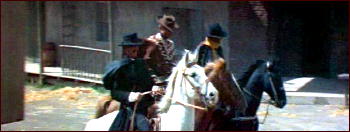
Credit where credit is due. I knew two of the three. The third one I needed a helping hand with, and it’s Steve M of Western Fiction Review whose suggestion in the comments I’ve just used. But here’s what’s important. What happens next will blow you away. It did me, and I know I wasn’t the only one.
The story itself begins only after this opening scene ends, as the notorious bandit Monetero (Gilbert Roland) makes plans with his gang to hold up the train that the job of Clayton, a tenderfoot banker (Edd Byrnes), depends on. The train is carrying a fortune ($300,000) in gold coins, and if the shipment doesn’t arrive safely, he’s likely to be given his walking papers.
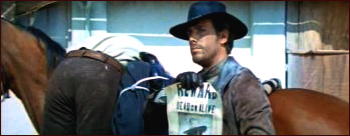
On Montero’s trail, however, is “The Stranger” (George Hilton), a bounty hunter with a thirst for ready cash, whether for the reward money or the stolen gold… Oops. I missed telling you about that. The holdup goes off with nary a hitch (except for leaving a humongous body count behind), and a double cross on the part on one of the bandits means that the gold’s hidden somewhere not too far away, but exactly where? Dead men cannot say.
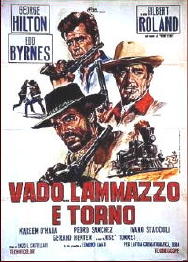
There is more than one double cross in what follows next, triple crosses — why not? — and even perhaps a quadruple cross or two. A fortune in gold coins does that to people’s minds.
There is a point, about two-thirds of the way through, where the subtly of the spoof so far — and for a long time the film is played so straight that you begin to believe that the opening scene was only an homage and not a hint of things to come — turns and becomes what is almost all out comedy, thus tending to spoil the effect.
A hint at the right place and at the right time may be all that’s needed — a wink from one of the players, perhaps, not much more — and although extremely well choreographed, the fight scenes tend to go on too long.
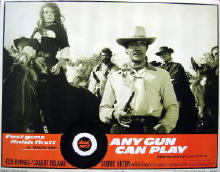
It’s all a matter of perspective, of course. What jiggles one person’s sense of humor immensely may need a much bigger poke to make another person smile or laugh. All in all, while I didn’t laugh out loud all that much, I certainly smiled a lot.
And, oh. One last thing. While the two young guys displayed their talents well, I think Gilbert Roland, at the age of 62, stole the show. Suave and utterly unflappable as the bandit Monetero, I think he showed Mr. Byrnes and Mr. Hilton a thing or two.
With a lifetime of filmmaking behind him, including a short stint as the movie’s Cisco Kid, he was at ease in his role as if he’d been a notorious Mexican bandit all his life.
June 26th, 2009 at 11:54 pm
I think I’m paraphrasing Leonard Maltin that no movie was ever worse for the presence of Gilbert Roland, and most were considerably better. Roland dates back to the silent era where they tried to sell him as a new Valentino, did at least one film with Mae West, and ended up one of the most dependable character actors in the business. He acted well into his eighties, appearing in Hart to Hart on television and with Willie Nelson and Gary Busey in a western film (sorry, the name escapes me).
He was the lead opposite Jane Russell in The French Line, but I mostly remember him in films like Last Train From Madrid with Henry Fonda, Malaya with James Stewart and Spencer Tracy, John Huston’s We Were Strangers with John Garfield, The Last of the Fast Guns with Jock Mahoney, Treasure of Pancho Villa with Rory Calhoun and Shelly Winters, Ten Tall Men with Burt Lancaster, and Bandido with Robert Mitchum. He was almost always better than the material — even in good films.
I can’t say why, but his singing and strumming the guitar in the final scene of Huston’s We Were Strangers has always stuck in my mind.
And I always got the idea that Robert L. Fish’s Captain Jose Da Silva was modeled on Roland, but that may just have been me.
In one sense he had played a notorious Mexican bandit all this life. His Cisco Kid films were good, but he always seemed a little too intense for the character despite hie easy charm, but that again may just have been me. He was always at his best when he was given a role with a little edge to it.
I won’t say he was never in a bad movie, but he was never bad in a movie, and that’s a pretty good record in itself when you consider his career ran from the 20’s to the 80’s.
And yes, he walks off with this one without even trying though it’s a good little film and Hilton was one of the better Italian western leads of the period. Funnily enough he didn’t look a great deal older in that Willie Nelson picture than he did in this one. The man was ageless — as was his appeal.
June 27th, 2009 at 12:25 pm
The film with Nelson and Busey was BARBAROSA. Came out in 1980, I believe.
June 27th, 2009 at 1:12 pm
I always thought the third rider was meant to be Franco Nero (Django). The film is also known as “I Go, I Shoot, and I Return”
June 27th, 2009 at 1:55 pm
Dozy
You’re right about BARBAROSA, but the year was 1982. Gilbert Roland would have been 77 then. I remember seeing the movie, but that’s about all. Nothing or no one in it, except Willie Nelson, comes back to me. Another one I’ll have to watch again!
Steve M
I think you’re right also. Franco Nero (Django) is a better choice than Gian Marie Volonte’s El Indio as the third gunman. Django is a movie I’ve never seen, and he never occurred to me. (It’s such a better choice that I’ve gone ahead and rewritten that portion of my review.)
— Steve